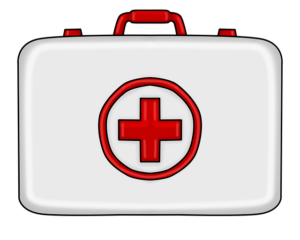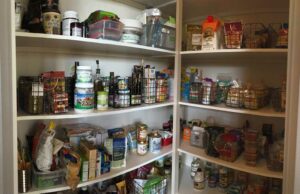by Jayme Radomski | Jun 23, 2020 | Clutter, Organizing
 Due to the size and location, a garage organizing project should be completed in three phases (gather and sort items, cleaning and painting, and organizing systems). Consider the garden shed to be included with the garage, as the items stored here are similar to items in your garage. Before you get started on this project, make a quick list of all the items in your garage and shed. This list can be general categories such as tools, toys, automotive supplies, lawn care, snow removal, camping, etc. Think about what you need to keep, can sell or will dispose of, and take note of these items.
Due to the size and location, a garage organizing project should be completed in three phases (gather and sort items, cleaning and painting, and organizing systems). Consider the garden shed to be included with the garage, as the items stored here are similar to items in your garage. Before you get started on this project, make a quick list of all the items in your garage and shed. This list can be general categories such as tools, toys, automotive supplies, lawn care, snow removal, camping, etc. Think about what you need to keep, can sell or will dispose of, and take note of these items.
Phase 1: Gather and Sort
The gather and sort phase can be a big task. Feel free to work through this phase category by category or area by area. Once you have gathered and sorted each area, identify what you will keep and group into categories. Grouping like items together will help plan for storage of these items. Selecting bins of appropriate size and purchasing storage systems will be much easier and purposeful with a plan. Remember, items that are used in the garage or outside your home get stored in the garage or shed, items that are used in your home get stored in your home. These are the steps for the gather and sort phase:
• Gather all items from garage, shed and areas that have garage related items
• Sort items into categories
• Purge items that are not needed (sell, donate or dispose)
• Organize and categorize into storage containers
• Identify storage location (garage, shed, other)
• Label
Phase 2: Cleaning and Painting
Phase 2 is where you prepare your garage for storage. You will want to remove any existing storage systems, thoroughly clean the floors and walls, and apply a fresh coat of paint to areas you want painted. A light gray, light beige or white color on the walls will make the garage feel larger and brighter. This is also time to refresh the lighting and apply a sealer to the garage floor if you desire. Here are the basic steps to this phase:
• Remove exiting storage systems
• Clean
• Paint
Phase 3: Organizing System
A well -planned organizing system for your garage will help keep your garage organized. You will need to go vertical to maximize the storage capacity. Wire shelving works great as it allows for airflow and is easily adjustable for your changing needs. Clear bins with labels allow you to see the contents of each bin. Cabinetry can make your garage visually appealing if your budget allows. Yard tools can be displayed with peg board or other tool hanging systems. What ever you choose, be sure the system is adjustable and simple. Over designing and overthinking exactly where each little tool will go may restrict your changing needs.
At Top Shelf Home Organizing we make garage organizing manageable and easy. Contact Jayme to see how we can help you get your garage organized.
by Jayme Radomski | Apr 2, 2020 | Money & Paper Management, Organizing
 Being organized can be especially helpful in times of emergency. It is a good idea to have an emergency kit ready to go, and to have a plan that is communicated to all members of your household. The list of items that could be needed is exhaustive and endless. The importance of being prepared means you have the supplies and documents ready for your household in case of an evacuation, as a worst-case scenario. Keep in mind, business could be closed, banks could be closed and the internet could be down. Here is a guide of suggestions to getting organized for emergencies. A formal kit can be found at ready.gov.
Being organized can be especially helpful in times of emergency. It is a good idea to have an emergency kit ready to go, and to have a plan that is communicated to all members of your household. The list of items that could be needed is exhaustive and endless. The importance of being prepared means you have the supplies and documents ready for your household in case of an evacuation, as a worst-case scenario. Keep in mind, business could be closed, banks could be closed and the internet could be down. Here is a guide of suggestions to getting organized for emergencies. A formal kit can be found at ready.gov.
Food and Water
- 7- to 10-day supply of non-perishable food and water
- Include some comfort foods to help ease anxiety
- One gallon of water per person per day as a guideline
Money
- Small denominations, ten-, five- and one-dollar bills
- To purchase food, gas, other daily needs
- Amount depends on the size of your family ($2,000 cash is a good starting point to allow for basic needs and travel if evacuation is needed)
Medications
- Prescriptions for at least two weeks
- Non-prescription including pain relievers, stomach remedies, cough and cold remedies, fluids with electrolytes, and vitamins
- Medical records
Documents
Store copies of these in a fire proof safe inside a water-tight container, in a bank safe deposit box, and copies at a trusted friends or relative. You can also keep a digital copy in a removable drive.
- Personal Information
- Driver’s license or another photo ID
- Birth certificates, adoption certificates, custody documents
- Marriage license, divorce degree
- Social security card
- Child identity cards
- Passport/green card, naturalization documents
- Military: military id, military discharge record
- Pet: id tags, prove of ownership, microchip information, emotional support letter, certification for service animals
- Household Information
- Name, date of birth, place of birth
- Address and mailing address
- Name of spouse or partner
- Employment information including supervisors with contact information
- Spouse employment information
- Emergency contact
- Children information: name, address, date of birth, email, phone, school
- Financial and Legal
- Estate planning
- Living will, trust, power of attorney and advanced directives
- Financial
- Checking, saving, investments, retirement
- Print and keep a hard copy of the most current bank: name of institution, type of account, account number, institution phone number and website
- Sources of income
- Pay stubs, government benefits, alimony, child support, rewards accounts
- Tax Statements
- Previous year’s tax return, property tax, personal property tax
- Insurance
- Health, property, life, automobile, disability, appraisals, pet, flood, funeral
- Firm name, name of policy holder, policy number, claims phone number, type of policy, value, coverage period, website
- Understand how your home or renter’s insurance can assist you in an emergency
- Video or photograph rooms in your home and valuable belongings
- Financial Obligations
- Housing, utility, loan, credit card, child support
- Have a list of what bills are on autopay, download and print a copy of your last statement or applications to enroll
- Document and print your FICO score
Fuel
- Keep tank of gas above half full at all times
- Have fuel available for your back up generator
Supplies
- Battery-powered or hand crank radio and NOAA Weather Radio with tone alert
- Flashlight and extra batteries
- First aid kit
- Whistle
- Dust mask
- Plastic sheeting and duct tape to create a shelter
- Moist towelettes or wet wipes, trash bags with ties for personal sanitation
- Tools (wrench or pliers) to turn off utilities
- Can opener for canned food
- Local maps
- Cell phone with charger
- Battery pack charger for phone
- Personal hygiene supplies
At Top Shelf, we love to help busy families plan and prepare. If thought of planning for an emergency is overwhelming, see how Jayme and her team can help.
by Jayme Radomski | Mar 10, 2020 | Bathroom, Clutter, Organizing
 Let’s be ruthless and get our overstuffed linen closets cleared out for real. We expect these little closets to hold too many items. To get the linen closet to a reasonable condition, lets look at the contents category by category. Empty out all the contents of this closet. Also, consider linen closet items that are not stored in the linen closet but fall into these categories. You might find these items in your bathroom, under your bed, in the kitchen, in the bedroom closet, and possibly in the car, garage, basement or attic. After we retrieve these items from around the house, sort them by category. Once we follow the guidelines below for each category, we can have fun organizing them back into the closet and labeling for continued organization.
Let’s be ruthless and get our overstuffed linen closets cleared out for real. We expect these little closets to hold too many items. To get the linen closet to a reasonable condition, lets look at the contents category by category. Empty out all the contents of this closet. Also, consider linen closet items that are not stored in the linen closet but fall into these categories. You might find these items in your bathroom, under your bed, in the kitchen, in the bedroom closet, and possibly in the car, garage, basement or attic. After we retrieve these items from around the house, sort them by category. Once we follow the guidelines below for each category, we can have fun organizing them back into the closet and labeling for continued organization.
At Top Shelf, we feel less is more and we like to keep only what we need. Here is a guideline of some typical items to consider.
- Paper Products
The linen closet is an ideal space to store extra paper products such as toilet paper and facial tissue. Keep a minimal amount of back up product in your bathroom due to limited space and the humid environment. Purchasing paper products in bulk can save money, but be aware of your storage space. You will want to avoid too much overflow into other areas of your home, unless you have ample overflow storage.
- Bath Towels
Keep two towels per person living in your house, and a couple fresh towels for guests. The extra towels can be donated to a local pet shelter.
- Hand Towels
Keep two or three hand towels per bathroom, or two hand towels per person living in your home. A couple fresh hand towels for guests is acceptable. Extra towels can be donated to a local pet shelter.
- Wash Clothes
Inventory your wash clothes and keep exactly what your family uses per week. Some people may use two wash clothes per day and others may only use a wash cloth on occasion. This category is very specific to your household. Consider donating extras to an animal shelter.
- Beach Towels
Beach towels are also unique to your household. The amount you need will depend on your lifestyle, how often you are at the beach, at the pool, on a boat or camping. You will need to figure out how many beach towels are reasonable to keep. If your kids spend their summer at camp with a swimming pool, you may want to consider a few extra towels in your inventory. If your family is more of a weekend warrior at the beach and lake, one towel per person is reasonable. These seasonal towels can be packed away and placed into storage during the winter, if they are not needed. Remember, you can always toss them in the wash when you get back from the lake or the pool so they are ready for the next day. Extra beach towels can also be donated to a local animal shelter.
- Medical Equipment
Medical equipment can take up a large section of real estate in a linen closet. Equipment only used seasonally or during an occasional illness may be stored in another location such as the basement or a larger closet. Equipment that is used regularly can remain in the linen closet as long as there is space.
- Medications
Medication’s should be gone through on a regular basis. When going through medications, gather all your medications in one location. Check the expiration dates of all medications. Also, consider medications that are not needed anymore. After the unneeded and expired are removed, you can sort the remaining into categories such as daily use, illness specific and kids’ medications. Local pharmacies and governments host collection days to safely dispose of medications.
- Toiletries and Personal Care Items
Toiletries and personal care items should be gathered and sorted. Remove the items that are expired, old and not used anymore. Place partially used products in the front of the closet to use them up first. Plan to use up your inventory of products before purchasing new items. Write down your inventory or take a photo to help resist the temptation to purchase these products before depleting what you have. These products tend to build-up, especially if you are into trying the newest products. Unopened, unexpired and unwanted products can be donated to local homeless shelters.
- Cosmetics
Before we dive into cosmetics, lets have a quick general discussion on the shelf life of them. In general, unopened cosmetics have a shelf life of two to three years. This depends on the product and where the product is stored. If a product is exposed to heat, light and humidity, even if unopened, the shelf life is reduced. A list of typical shelf lives of products is provided. However, the method of application will affect the life of the products. If you use your fingers and hands to apply products or do not keep applicators clean, the life is reduced due to the bacteria allowed to enter the product.
Application brushes: two to five years
Blush: one to two years
Eye shadow: one to two years
Eye liners and pencils: one to two years
Foundation: six to eighteen months
Lip products: one to two years
Mascara: three months
Skin care products: six months to one year
Sunscreen: one to two years
- Bed Sheets
The linen closet easily becomes a graveyard for old, unused bedding. These items should be cleared out of the closet, and grouped by set and size. Then, you can decide on what sets to keep and what sets to donate. Two sets per bed is a good rule of thumb. Keep an extra mattress protector for each size of bed, if you have young kids in the house. One set of bedding for the guest bed is plenty. If needed, you could pull a set from your regular bedding for the guest bed. Organize the sheets sets you plan to keep by bed size, and place them into a linen bag or in a labeled bin or basket.
- Non-Linen Closet Items
Any item that does not fall into the linen closet categories doesn’t need to be in the linen closet. Items often found in a linen closet include food, toys, games and clothing. These items could be placed in the kitchen or bedroom closets.
At Top Shelf, we love to see the freedom organizing a small space can bring to you and your household. Let us know how your linen closet project goes by posting photos at Top Shelf Home Organizing Facebook page. Need some guidance getting started, get in touch with Jayme.
by Jayme Radomski | Jan 8, 2020 | Clutter, Organizing, Saving Time

Setting Realistic Organizing Goals
In this new year and new decade, I want to share with you some simple ideas on how to set goals to be more organized in 2020. Being organized is a journey. To expect to become completely organized this month if you have not been organized in the past year or decade is unrealistic. Setting small weekly goals to get your home organized will be more manageable, leave you time to continue with your daily activities, and allow you to celebrate many small victories.
5 W’s of Goal Setting
Take some time to think about the benefits of being organized, and what that will look and feel like for you. Start a journal or notebook to track your progress, motivations, slowdowns and feelings. A good guideline for setting goals is to look at the five W’s.
- Why is it important for you to become and stay organized? How will this help you to be the best you?
- Where do you think you need the most organization? Is it an area of your home? Is it an area of your office? Would having more structure to your schedule be beneficial?
- When will you accomplish your goals? When will you make time to work on your goals? Set a realistic time frame to meet your goals. Getting organized is a journey, not a one-stop trip. Plan time in your days and your weeks to accomplish small goals.
- Who will be affected by being organized? Obviously you will directly benefit. Think about the other people who will positively benefit from organization and structure. Your boss will feel the benefits of your workspace being organized and your schedule more structured. Family members will see the benefits of an organized home and feel the benefits of you being less stressed. Relationships will flourish when this area of your life is under control.
- What do you want to organize? Look at the big picture and break it down into small steps and then into even smaller steps. If you want your entire home, office, storage unit, garage, attic and vacation home organized, you will need to set goals in each area. Furthermore, goals will need to be set for each room, and then even smaller goals will need to be set for each file, drawer, closet, box and bin. For example, if your goal is an organized bedroom, you will want to break your bedroom down into smaller categories. These smaller categories could include closet, dresser, under bed storage, bathroom and linen closet. Each of these areas can be broken down into very small projects that take just minutes. Your dresser can be separated into smaller categories such as undergarments, socks, pajamas, swimwear, t-shirts and accessories. A similar method can be applied to other areas.
Goal Setting Basics
- Specific
Be specific about your goals. Goals should be specific to what you really want and need to be organized. Go further than general statements like “I am going to get organized” and “I am going to organized my whole house.” Specific goals will go deep and detail areas of your home, and further into rooms, and then into drawers, closets, categories, boxes and bins.A calendar is a great way to break down your project into small specific goals. Each month you will have a large goal. The large goal can be broken down into smaller weekly goals, and then even further into very manageable daily goals. The smaller goals should be focused on achieving a larger goal to ensure a part of the project gets completed. If you are working on basement organizing, the smaller goals should lead you to accomplishing that larger goal.
- Measurable
You will want to have a way to measure your progress. Progress with getting organized can be a photo to visually remind you of what you have accomplished. It will help to know where you started and how far you have come. A simple check list or spreadsheet can also help you mark off your progress.
- Attainable
Set goals that you can achieve. Success meeting your goals will motivate you to keep going. Setting goals that will only take minutes a day will be more attainable than goals that take many hours out of your week. An attainable goal for you may be cleaning and organizing a refrigerator shelf, not the entire refrigerator. It will always feel better to move on to the next small goal when you have time than to set goals so large you cannot complete even one.
- Realistic
Be realistic about your time, lifestyle and goals. If your weekends are packed with running to activities and enjoying time with family and friends, you may only have a few minutes to work on your goals. Don’t plan to organize your entire office on Saturday if you have a full schedule. That will only lead to failure and frustration.
- Timely
Set timely organizing goals. Making progress will keep you motivated. If you plan for an organizing project to go on too long, you may lose focus. Planning your goals to be accomplished in a timely manner will help you and others see and learn that progress has happened and keep you going.
There are many monthly and daily organizing calendars available online. These can provide a great guide for you to plan your organizing journey. Top Shelf Home Organizing would love to help you on your journey. Jayme would be happy to help you set your organizing goals, and help you achieve your organizing goals.
by Jayme Radomski | Oct 10, 2019 | Cooking & Kitchen, Organizing, Pantry
 Autumn is a great time to clear out the pantry and make room for fall foods, baking supplies and entertainment planning items. A fresh pantry will reignite your love for cooking and give your kitchen a little refresh. Clearing out and inventorying the food in your pantry can help with your meal planning and grocery shopping. We have put together four simple, practical tips for getting your pantry organized this fall.
Autumn is a great time to clear out the pantry and make room for fall foods, baking supplies and entertainment planning items. A fresh pantry will reignite your love for cooking and give your kitchen a little refresh. Clearing out and inventorying the food in your pantry can help with your meal planning and grocery shopping. We have put together four simple, practical tips for getting your pantry organized this fall.
- Remove all food and other items from your pantry
You will also want to gather food you have stored in other areas of your home. While the pantry is empty, it’s a great time to thoroughly clean all surfaces for a fresh start. Ahead of this project, consider purchasing the food you typically keep on hand. This is an important part of allocating adequate space in your pantry.
- Sort and categorize your food
During this process, you can categorize the food on your kitchen countertops and dining room table. Remove and dispose of expired food. Relocate nonfood items, especially if your pantry space is limited to another storage area of your kitchen or home. Categorize your food into snacks, canned goods, grains, pastas, nuts & seeds, etc.Strategize where food will go in your pantry based on the categories, quantity of food and convenience. You will want frequently used items within reach. Occasionally used items can go on higher, less convenient shelves. You may or may not want kids snack items within their reach.
- Purchase storage products
If you need them, explore and purchase storage containers that will work well for your pantry. Clear bins work great for corralling snack bars, chips and items that come in soft packaging. If you tend to purchase bulk grains, nuts, etc., you may want to consider tight sealing, clear containers for storage of these items that do not come with their own packaging. Measure your space carefully prior to buying storage items, as you want them to fit well in the space they will be used.Also be careful not to overcomplicate containers. Many times, placing pre-packaged food into containers may be more work than needed. Consider food rotation when deciding on containers. You will want to make sure the older food gets used first. Coordinating containers can make the pantry aesthetically pleasing.I also suggest labels for all containers. This will help ensure everyone knows where to return food to the pantry. Adding pull out drawers and baskets are nice for deep shelves to make all items visible and accessible. You can utilize the pantry doors for storage of lightweight, narrow items.
- Return food to pantry
Returning food to the pantry is fun. This is where you get to utilize any new storage products, decide on the best location for the food, and label the bins and containers. Remember that food goes with food in the pantry. Non-food items go with non-food items, and may need to be stored in other areas. The slow cooker you use two times per year, the holiday candles, or kids craft supplies may not have a home in your pantry, especially if you are low on space. Limit food storage in other areas such as the hall closet, bathroom, garage, and basement unless necessary.
Bonus Step: Create a meal plan that utilizes the food you have in your pantry. This will save you cash on your next shopping trip.
Pantry organizing can be a fun and easy organizing project that is good to do with the season changes. For a kick start on organizing your pantry, see if Top Shelf Home Organizing can help you. Contact Jayme for advice. We love what a fresh pantry will do for you.
by Jayme Radomski | Jul 16, 2019 | Organizing
 When consulting with a professional organizer, they will ask a set of important questions. To prepare you for your own organizing project, or for your first meeting with an organizer, a list of these standard questions is below. Why these questions are so important is included as well.
When consulting with a professional organizer, they will ask a set of important questions. To prepare you for your own organizing project, or for your first meeting with an organizer, a list of these standard questions is below. Why these questions are so important is included as well.
- Name
Who will the work be done for? Are you getting yourself organized or is this for a family member or a friend?
- Address
Location where the organizer will be working so travel time can be planned, as well as access to stores where supplies may need to be purchased to complete a project.
- Phone and Email Address
Phone number and email address are needed for contacting you with questions before, during and after the project, as well as invoicing and follow-up coaching.
- Area(s) to be organized
Create a list of areas you desire to have organized in order of their priority. Have this question prepared before you have an on-site consultation with an organizer so they can help you set goals and prioritize your needs. Setting a reasonable timeframe for when you would like the projects complete is helpful for planning and budgeting the project.
- Who uses the space?
It is helpful to know who uses the space to be organized. This could be employees, children, adult family members, your self or nanny/babysitter.
- What is the space used for?
What a space is used for helps prioritize what items should be left in the space. If a kitchen, for example, doubles as an office or kids craft area, space may be allocated for storing those other supplies.
- What is your time frame for meeting your goals?
Do you want your spaces organized in the near term, or do you want your top priority completed sooner and the rest of your goals spread out through the next months or year
- What are your biggest obstacles to getting this space organized?
Understanding what your personal obstacles for organizing and maintaining organization in the space helps the organizer plan the project. Obstacles often include time, family members and budget.
- What are your goals?
What does an organized space look like to you? Everyone has a different perspective on being organized. One person may prefer everything sorted by category in neatly labeled and matching containers. Another person may feel organized by having items in their correct location, but not necessarily neatly labeled with matching bins.
- Will you be working with the organizer the entire time, some of the time or not at all?
Do you plan to work one-on-one with the organizer? Or do you plan to have the organizer complete the project independently? Working with the organizer for part of the time is also an option. Think about what works best for you and your schedule.
- What is your budget for organizing?
Communicating your budget with the organizer helps them plan for your custom project and what materials may need to be purchased. A lower budget project can reuse boxes and bins that you currently own. A higher budget project may allow for new storage solutions.
- Have you worked with an organizer before?
Understanding if you have worked with an organizer before and what you enjoyed most about the experience is helpful for customizing your session.
- How many people live in the home?
Knowing how many people live in the home or work in an office is also important. Clear labels and communication on storage solutions is more important to the success of an organizing project with more people involved. A single person is able to maintain an organized space with less labels and communication.
- How long have you lived in your home?
Learning how long a person or family has been in a home gives insight to the duration and quantity of items that may be in a home.
- Do you have a storage unit?
It is helpful to know if and what items are stored offsite.
- Do you have storage in your attic?
It is helpful to know if you do and what items are in storage in your home.
- Do you have storage in your basement?
It is helpful to know if you do and what items are in storage in your home.
- Do you have any questions for the organizer?
Preparing a list of questions upfront for your organizer will help you determine if hiring an organizer is a good fit for you, and if he or she is someone you think matches your lifestyle, personality and needs.
These are great questions to think about before contacting a professional organizer. The questions will help you prepare for and make the most of the initial phone conversation or on-site consultation. At Top Shelf Home Organizing, we love to help busy people get organized. See if Top Shelf Home Organizing can help you get your next organizing project started and completed. Contact Jayme to schedule a consult or chat about organizing.
 Due to the size and location, a garage organizing project should be completed in three phases (gather and sort items, cleaning and painting, and organizing systems). Consider the garden shed to be included with the garage, as the items stored here are similar to items in your garage. Before you get started on this project, make a quick list of all the items in your garage and shed. This list can be general categories such as tools, toys, automotive supplies, lawn care, snow removal, camping, etc. Think about what you need to keep, can sell or will dispose of, and take note of these items.
Due to the size and location, a garage organizing project should be completed in three phases (gather and sort items, cleaning and painting, and organizing systems). Consider the garden shed to be included with the garage, as the items stored here are similar to items in your garage. Before you get started on this project, make a quick list of all the items in your garage and shed. This list can be general categories such as tools, toys, automotive supplies, lawn care, snow removal, camping, etc. Think about what you need to keep, can sell or will dispose of, and take note of these items.




